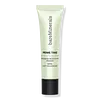What's inside
What's inside
 Key Ingredients
Key Ingredients

 Benefits
Benefits

 Concerns
Concerns

 Ingredients Side-by-side
Ingredients Side-by-side

Water
Skin ConditioningAloe Barbadensis Leaf Juice
Skin ConditioningPentylene Glycol
Skin ConditioningCoco-Caprylate/Caprate
EmollientC15-19 Alkane
SolventMica
Cosmetic ColorantGlyceryl Stearate Citrate
EmollientGlycerin
HumectantSilica
AbrasiveMacadamia Integrifolia/Tetraphylla Seed Oil
EmollientGlyceryl Stearate
EmollientSimmondsia Chinensis Seed Oil
EmollientGluconolactone
Skin ConditioningSodium Hyaluronate
HumectantLactobacillus Ferment
Skin ConditioningLactobacillus
Skin ConditioningCocos Nucifera Fruit Extract
EmollientGlyceryl Caprylate
EmollientTocopherol
AntioxidantGalactoarabinan
Hydrogenated Olive Oil Stearyl Esters
Emulsion StabilisingXanthan Gum
EmulsifyingSodium Stearoyl Glutamate
CleansingSodium Chloride
MaskingSodium Gluconate
Skin ConditioningCI 77002
Cosmetic ColorantCI 77491
Cosmetic ColorantCI 77492
Cosmetic ColorantCI 77499
Cosmetic ColorantCI 77891
Cosmetic ColorantWater, Aloe Barbadensis Leaf Juice, Pentylene Glycol, Coco-Caprylate/Caprate, C15-19 Alkane, Mica, Glyceryl Stearate Citrate, Glycerin, Silica, Macadamia Integrifolia/Tetraphylla Seed Oil, Glyceryl Stearate, Simmondsia Chinensis Seed Oil, Gluconolactone, Sodium Hyaluronate, Lactobacillus Ferment, Lactobacillus, Cocos Nucifera Fruit Extract, Glyceryl Caprylate, Tocopherol, Galactoarabinan, Hydrogenated Olive Oil Stearyl Esters, Xanthan Gum, Sodium Stearoyl Glutamate, Sodium Chloride, Sodium Gluconate, CI 77002, CI 77491, CI 77492, CI 77499, CI 77891
Water
Skin ConditioningDecyl Cocoate
EmollientCoco-Caprylate/Caprate
EmollientCaprylic/Capric Triglyceride
MaskingTriheptanoin
Skin ConditioningKaolin
AbrasivePropanediol
SolventAvena Sativa Kernel Oil
Skin ConditioningCetearyl Olivate
Cellulose
AbsorbentOleyl Erucate
EmollientSqualane
EmollientSorbitan Olivate
EmulsifyingC9-12 Alkane
SolventDilinoleic Acid/Butanediol Copolymer
Chamomilla Recutita Flower Extract
MaskingHelianthus Annuus Seed Oil
EmollientTocopherol
AntioxidantBisabolol
MaskingSalicyloyl Phytosphingosine
Skin ConditioningPentaerythrityl Tetra-Di-T-Butyl Hydroxyhydrocinnamate
AntioxidantSulfur
AntiseborrhoeicHydrogenated Palm Glycerides Citrate
EmollientZinc Ricinoleate
Magnesium Aluminum Silicate
AbsorbentCetearyl Alcohol
EmollientCetyl Palmitate
EmollientGlycerin
HumectantSorbitan Palmitate
EmulsifyingEthylene/Propylene/Styrene Copolymer
Xanthan Gum
EmulsifyingSorbitan Oleate
EmulsifyingCastor Oil/Ipdi Copolymer
Acacia Senegal Gum
MaskingMica
Cosmetic ColorantButylene/Ethylene/Styrene Copolymer
Phenoxyethanol
PreservativeCI 77163
Cosmetic ColorantCI 77289
Cosmetic ColorantCI 77288
Cosmetic ColorantZinc Oxide
Cosmetic ColorantWater, Decyl Cocoate, Coco-Caprylate/Caprate, Caprylic/Capric Triglyceride, Triheptanoin, Kaolin, Propanediol, Avena Sativa Kernel Oil, Cetearyl Olivate, Cellulose, Oleyl Erucate, Squalane, Sorbitan Olivate, C9-12 Alkane, Dilinoleic Acid/Butanediol Copolymer, Chamomilla Recutita Flower Extract, Helianthus Annuus Seed Oil, Tocopherol, Bisabolol, Salicyloyl Phytosphingosine, Pentaerythrityl Tetra-Di-T-Butyl Hydroxyhydrocinnamate, Sulfur, Hydrogenated Palm Glycerides Citrate, Zinc Ricinoleate, Magnesium Aluminum Silicate, Cetearyl Alcohol, Cetyl Palmitate, Glycerin, Sorbitan Palmitate, Ethylene/Propylene/Styrene Copolymer, Xanthan Gum, Sorbitan Oleate, Castor Oil/Ipdi Copolymer, Acacia Senegal Gum, Mica, Butylene/Ethylene/Styrene Copolymer, Phenoxyethanol, CI 77163, CI 77289, CI 77288, Zinc Oxide
Alternatives
Ingredients Explained
These ingredients are found in both products.
Ingredients higher up in an ingredient list are typically present in a larger amount.
Coco-Caprylate/Caprate is created from fatty coconut alcohol, caprylic acid, and capric acid.
It is a lightweight emollient. Emollients create a thin barrier on the skin to trap moisture in. This helps keep your skin hydrated and soft.
Once applied, Coco-Caprylate/Caprate is absorbed quickly and leaves a silky feel.
Coco-Caprylate/Caprate may not be fungal acne safe.
Learn more about Coco-Caprylate/CaprateGlycerin is already naturally found in your skin. It helps moisturize and protect your skin.
A study from 2016 found glycerin to be more effective as a humectant than AHAs and hyaluronic acid.
As a humectant, it helps the skin stay hydrated by pulling moisture to your skin. The low molecular weight of glycerin allows it to pull moisture into the deeper layers of your skin.
Hydrated skin improves your skin barrier; Your skin barrier helps protect against irritants and bacteria.
Glycerin has also been found to have antimicrobial and antiviral properties. Due to these properties, glycerin is often used in wound and burn treatments.
In cosmetics, glycerin is usually derived from plants such as soybean or palm. However, it can also be sourced from animals, such as tallow or animal fat.
This ingredient is organic, colorless, odorless, and non-toxic.
Glycerin is the name for this ingredient in American English. British English uses Glycerol/Glycerine.
Learn more about GlycerinMica is a naturally occurring mineral used to add shimmer and color in cosmetics. It can also help improve the texture of a product or give it an opaque, white/silver color.
Serecite is the name for very fine but ragged grains of mica.
This ingredient is often coated with metal oxides like titanium dioxide. Trace amounts of heavy metals may be found in mica, but these metals are not harmful in our personal products.
Mica has been used since prehistoric times throughout the world. Ancient Egyptian, Indian, Greek, Roman, Aztec, and Chinese civilizations have used mica.
Learn more about MicaTocopherol (also known as Vitamin E) is a common antioxidant used to help protect the skin from free-radicals and strengthen the skin barrier. It's also fat soluble - this means our skin is great at absorbing it.
Vitamin E also helps keep your natural skin lipids healthy. Your lipid skin barrier naturally consists of lipids, ceramides, and fatty acids. Vitamin E offers extra protection for your skin’s lipid barrier, keeping your skin healthy and nourished.
Another benefit is a bit of UV protection. Vitamin E helps reduce the damage caused by UVB rays. (It should not replace your sunscreen). Combining it with Vitamin C can decrease sunburned cells and hyperpigmentation after UV exposure.
You might have noticed Vitamin E + C often paired together. This is because it is great at stabilizing Vitamin C. Using the two together helps increase the effectiveness of both ingredients.
There are often claims that Vitamin E can reduce/prevent scarring, but these claims haven't been confirmed by scientific research.
Learn more about TocopherolWater. It's the most common cosmetic ingredient of all. You'll usually see it at the top of ingredient lists, meaning that it makes up the largest part of the product.
So why is it so popular? Water most often acts as a solvent - this means that it helps dissolve other ingredients into the formulation.
You'll also recognize water as that liquid we all need to stay alive. If you see this, drink a glass of water. Stay hydrated!
Learn more about WaterXanthan gum is used as a stabilizer and thickener within cosmetic products. It helps give products a sticky, thick feeling - preventing them from being too runny.
On the technical side of things, xanthan gum is a polysaccharide - a combination consisting of multiple sugar molecules bonded together.
Xanthan gum is a pretty common and great ingredient. It is a natural, non-toxic, non-irritating ingredient that is also commonly used in food products.
Learn more about Xanthan Gum